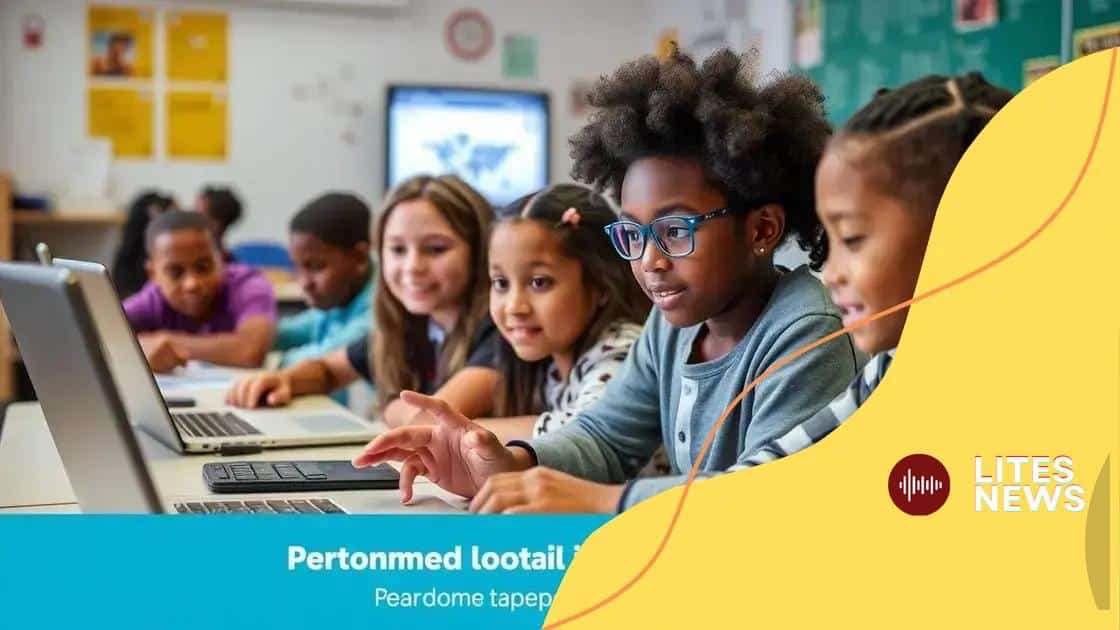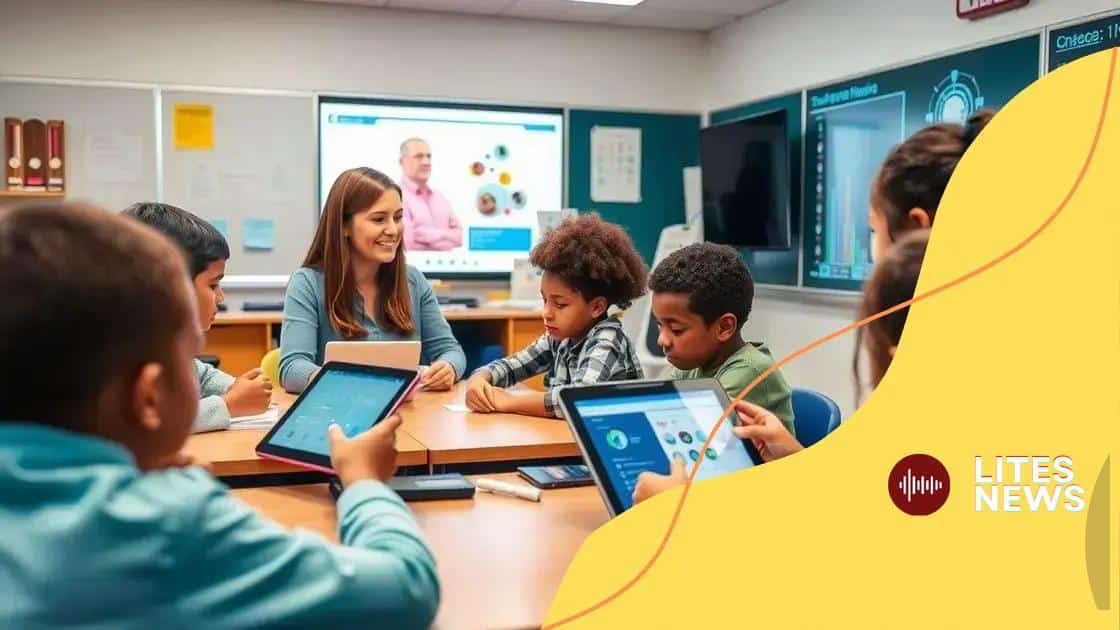AI support for special education: transforming learning experiences

AI support for special education enhances learning by providing personalized tools and resources, allowing educators to tailor instruction to meet the diverse needs of students with disabilities and improve overall educational outcomes.
AI support for special education is changing how we approach learning for students with unique challenges. Imagine a classroom where every child’s needs are met through tailored technology. Let’s dive in and explore what this means for education.
Understanding AI in special education
Understanding AI in special education is essential for grasping how technology can make a difference in the learning environment. As educators and parents seek innovative solutions, AI offers unique tools that can adapt to individual student needs.
How AI Works in the Classroom
Artificial intelligence leverages data to provide personalized learning experiences. By analyzing a student’s performance, AI can identify strengths and areas for improvement. This targeted approach is especially beneficial for students with special needs.
Key Benefits of AI in Special Education
- Personalization: AI can adjust lessons based on the pace and style of learning preferred by each student.
- Accessibility: Tools can be designed to support students with various disabilities, ensuring everyone has access to learning.
- Engagement: Interactive AI systems can keep students motivated and actively participating in their education.
- Data-Driven Insights: Educators can track progress in real-time, allowing for timely interventions.
Moreover, AI systems can assist teachers by automating repetitive tasks, freeing them to focus more on personalized instruction. For instance, instead of spending hours grading papers, AI can provide instant feedback on assignments. By streamlining administrative tasks, teachers can dedicate more time to creativity and interaction with their students.
Examples of AI Tools in Special Education
Several AI-powered tools have made significant impacts in classrooms. Programs like speech-to-text and text-to-speech systems are great for aiding students with communication difficulties. Other platforms utilize game-based learning to make materials more engaging for students with attention challenges.
As AI continues to evolve, the potential for enhancing the educational experiences of students with special needs grows exponentially. The use of analytics allows for better tracking of each student’s learning journey, promoting a more inclusive and supportive environment.
Benefits of AI for diverse learners
The benefits of AI for diverse learners are profound and varied. With the aid of artificial intelligence, students with different learning styles and needs can receive personalized support that enhances their educational experience.
Enhanced Learning Opportunities
AI technology enables educational platforms to offer tailored content that meets individual student requirements. For instance, software can adapt reading materials based on a student’s comprehension level. This kind of customization helps students grasp concepts more effectively and at their own pace.
Support for Different Learning Styles
- Visual Learners: Interactive tools can provide visual aids like videos and graphics to help these learners understand complex topics.
- Auditory Learners: Features like voice feedback and audio lessons cater to those who comprehend better through listening.
- Kinesthetic Learners: AI can facilitate hands-on activities through simulations and games that engage learners physically.
- Students with Disabilities: AI tools can modify content to accommodate various learning challenges, making education accessible to everyone.
Additionally, AI tools can foster deeper engagement among students by making learning more enjoyable. Gamification elements, such as rewards and leaderboards, can motivate students and encourage friendly competition. This approach can be particularly effective for diverse learners who might struggle with traditional educational methods.
Real-Time Feedback
One significant advantage of using AI in education is the ability to provide real-time feedback. This allows students to correct mistakes immediately rather than waiting for graded assignments. Instant support means that learners can continuously improve and adjust their learning strategies as needed.
Furthermore, teachers also benefit from these AI systems. By analyzing data from students, educators can understand patterns in learning and adjust their instruction accordingly. With insights on how different learners engage with the material, teachers can create lessons that better suit the needs of their diverse classrooms.
How to integrate AI in special education

Integrating AI in special education can enhance learning for students with diverse needs. It involves a blend of technology and teaching strategies to create an inclusive environment.
Identify the Needs
The first step is to identify the specific needs of students. Each learner is unique, with different challenges and strengths. Gathering information through assessments can help educators understand how AI can best support individual students.
Choosing the Right Tools
Once the needs are clear, selecting the right AI tools is crucial. Here are some options:
- Personalized Learning Platforms: Tools that adapt resources and activities based on student performance.
- Speech Recognition Software: Helps students communicate more effectively, especially those with speech difficulties.
- Interactive Learning Games: Engages students with fun, educational content while developing essential skills.
- Data Analytics Tools: Provides teachers with insights into each student’s progress and areas needing attention.
After choosing appropriate tools, it’s important to train staff and familiarize them with new technologies. Professional development workshops can help educators feel confident in using AI resources. Understanding how these tools function allows teachers to utilize them effectively in the classroom.
Implementation in Classroom Activities
Integrating AI into daily lessons can be straightforward. Start small by introducing one tool at a time. This gradual approach gives students a chance to adjust. For example, a teacher might use a personalized learning platform for math while continuing traditional methods for reading. Over time, as everyone becomes comfortable, more tools can be incorporated into various subjects.
Collaboration is key. Encourage teamwork among students during AI-driven activities. This promotes social skills while using technology. Setting clear objectives for each activity ensures all students understand what they are doing and how it helps them learn.
Continuous Assessment and Feedback
Finally, using AI means ongoing assessment. Many AI tools provide real-time results to track student progress. Teachers can review this data to adjust their strategies accordingly. Providing feedback to students helps them understand their growth and areas where they can improve.
Integrating AI in special education is not just about technology; it’s about enriching the learning experience for every student.
Real-life success stories of AI in classrooms
Real-life success stories of AI in classrooms highlight the transformative impact of technology on education. These examples show how AI can enhance learning experiences for students of all abilities.
Case Study: Smart Learning Systems
In a California school, teachers implemented AI-driven smart learning systems to tailor lessons for each student. The system analyzed how students performed on tasks and adjusted the difficulty of work accordingly. This personalized approach led to a noticeable improvement in student engagement and academic performance. Many students expressed excitement about learning, citing that lessons felt designed just for them.
Success with Speech Recognition Technology
A school in Texas introduced speech recognition software for students with speech difficulties. This technology helped students express their thoughts more freely and confidently. They could dictate their responses, which the AI transcribed accurately. As a result, students improved not only their communication skills but also their self-esteem, and the classroom became a more inclusive environment.
Interactive Learning through AI Games
In New York, teachers used AI-based educational games to engage students with learning disabilities. These games provided immediate feedback and adjusted challenges based on each student’s progress. The gamified approach made learning fun, and students were eager to participate. Teachers noted a significant increase in motivation and collaboration among students as they supported each other in the games.
Analytics for Informed Teaching
Another success story comes from a school in Florida that utilized AI analytics tools to track student progress. The data gathered allowed teachers to see which topics students struggled with the most. With this information, educators could tailor their instruction to address specific areas of need. The result was a marked improvement in overall class performance and a better understanding of student strengths and weaknesses.
These success stories demonstrate the potential of AI to create positive outcomes in education. By leveraging technology, schools can foster a more inclusive and effective learning environment for all students.
Future trends in AI for special education
Future trends in AI for special education promise exciting advancements that can revolutionize how educators support diverse learners. As technology evolves, it opens new opportunities for personalized learning experiences.
Increased Personalization
One major trend is the continued growth of personalized learning solutions. AI will allow even greater customization of educational content to meet individual student needs. Students will have access to resources tailored to their learning pace and style, making education more effective.
Expanding Use of Assistive Technologies
Assistive technologies powered by AI are becoming more prevalent. These tools can help students with disabilities communicate and learn more effectively. For example:
- Adaptive Software: Programs that adjust to the user’s skills, providing the right level of challenge.
- Voice-to-Text Tools: Enabling students to express their ideas verbally, which the software transcribes into written text.
- Augmented Reality: Offering immersive experiences that enhance learning through visualization and interaction.
- Language Translation Tools: Helping non-native speakers access content more easily.
Such tools enhance inclusivity and provide opportunities for all students, regardless of their challenges.
Data-Driven Insights
Another trend is the focus on data-driven insights. AI systems will increasingly analyze student data to provide teachers with actionable feedback. This information can help educators identify learning gaps and adapt their teaching strategies accordingly. By monitoring student progress in real-time, teachers can ensure timely interventions to support success.
Collaborative Learning Environments
AI will also foster more collaborative learning environments. Students will be able to work together online, utilizing AI tools that promote teamwork and communication. This collaborative approach can improve social skills and create a sense of community, even in remote learning situations.
As these trends develop, the role of AI in special education will only expand. With continuous advancements, educators can expect to see improved outcomes for all students, making learning accessible and engaging for everyone.
FAQ – Frequently Asked Questions about AI in Special Education
How can AI enhance learning for students with special needs?
AI can provide personalized learning experiences, allowing educators to tailor lessons to meet individual student requirements and learning styles.
What are some examples of AI tools used in special education?
Examples include speech recognition software, adaptive learning platforms, and AI-driven analytics tools that help track student progress.
How does AI support teachers in the classroom?
AI helps teachers by automating administrative tasks, providing real-time feedback on student performance, and offering insights that inform instructional strategies.
What future trends can we expect in AI for special education?
Future trends include increased personalization, enhanced assistive technologies, and the use of AI for collaborative learning environments.





